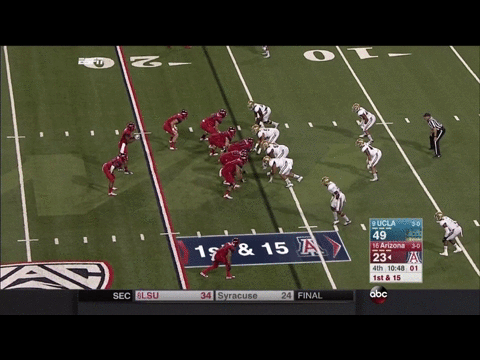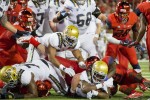Each week, Daily Bruin Sports takes a look at the game film for UCLA football and grades each position group on its performance.
This week, we grade UCLA’s 56-30 win over Arizona.
Quarterbacks: A
Thus far in his UCLA career, Josh Rosen has been a streaky player. When things start to go right for him, one completion leads to another. That much was evident in his debut performance against Virginia, when he completed 15 out of 16 passes at one point. Then against BYU two weeks later, the reverse held true: Rosen went ice cold, and the incompletions started to pile up. At one point in that game, Rosen threw just one completion over a span of eight passes – with two interceptions.
As the freshman quarterback said back in fall camp, the main thing he needs to work on is consistency.
“Sometimes I’ll get the same play and do two different things and come to the sideline and kind of not really know how to explain why,” Rosen said on Aug. 18. “I just gotta learn how to calm down and control my emotions and play within myself and not try to be a hero.”
He did that as much as ever against Arizona Saturday. Facing a 3-3-5 defense and a Pac-12 road environment for the first time in his college career, Rosen took what the defense gave him. He didn’t try to force passes downfield like he did against BYU, and was nearly perfect on third down.
Rosen’s performance against Arizona was impressive on many levels, from his poise in a raucous environment to his impromptu scrambles in key situations. But before pundits start putting him back in the Heisman Trophy race, they must first recognize that Arizona is not the measuring stick for a strong pass defense. The Wildcats entered the game ranked No. 92 in pass defense – even after facing feeble competition – and looked very exposable in the secondary.
Because of this defensive weakness, Rosen was able to telegraph a couple passes and still get away with it. Going forward, the freshman quarterback may not be able to do that.


Running backs: A-
It’s hard to come up with a definitive grade for the running backs in this one.
On one hand, they finished drives better than they had all year long. UCLA scored on all six of its red zone possessions, and the running backs were responsible for five of those touchdowns.
“We have not been good in our red zone touchdown percentage,” said coach Jim Mora. “And so we’ve put some emphasis on it, and it must have paid off.”
On the other hand, UCLA’s running backs were sorely lacking on efficiency and explosiveness. Redshirt junior running back Paul Perkins averaged just 3.0 yards per carry on his 12 first-down rushes, and his longest run of the day was 16 yards – albeit an impressive 16-yard touchdown run.
The one outside factor that comes into play here is the UCLA offensive line. On several occasions, a three-yard rush by Perkins was actually an accomplishment considering the shoddy blocking situation.

The one player who really buoyed this position group was Soso Jamabo. The freshman halfback flashed some of his five-star recruit potential by putting up 96 yards on nine carries. A good chunk of those yards came in garbage time, but garbage time or not, his spin move in the fourth quarter was a thing of beauty.

With Jamabo’s encouraging performance and the running backs’ overall success with finishing drives, the group should receive a solid grade.
Wide receivers: B
Two wide receivers really helped Rosen out against Arizona.
First off, junior Y receiver Thomas Duarte made a one-handed catch on a ball that was slightly overthrown by Rosen – and turned it into a 35-yard touchdown. Then there was senior X receiver Jordan Payton, who made two catches of over 35 yards despite playing on a bum ankle. His 39-yard streak early in the third quarter helped turn the momentum back in favor of UCLA after Arizona had scored the first 10 points of the second half.
“It was a big play for us. … They were killing us (early in the second half),” said offensive coordinator Noel Mazzone. “(Payton) made that play and it kind of got us going again.”
Aside from Payton and Duarte, however, there wasn’t much to cheer about in the wide receiver group.
Senior Devin Fuller went his second straight game without a reception, and redshirt sophomore Eldridge Massington did the same. Also, sophomore Mossi Johnson became essentially a non-factor in the passing game, and instead was used more on the defensive side of the ball at safety.

In fall training camp, it seemed like this position group had so much depth and potential, but against Arizona, it appeared to be pretty thin.
Still, the UCLA wide receivers only had one clear drop and over 120 yards after catches. That makes for a pretty solid grade – even if most of the work was done by two players.
Offensive line: B
Instead of trying to grade the offensive line myself, I asked redshirt senior center Jake Brendel to give his own assessment after the game.
“Well one sack was on a run play, the other sack was a true sack,” Brendel said. “I wouldn’t give us a bad grade, because two sacks on a four-game season is not bad. But at the same time, having zero sacks is better.”
Brendel was referring to the fact that UCLA’s offensive line gave up its first two sacks of the season against Arizona. Both sacks came at the start of the second half, when Arizona started to switch up its blitz strategy a little bit. The Wildcats started to increase the pressure off the blind side, and redshirt junior left tackle Conor McDermott was a bit slow to react.

“That was really uncharacteristic of our offensive line,” Mora said of the lapse early in the second half. “It’s a good looking offensive line. I mean they’re solid.”
For the first time all season, the Bruin offensive line started to show cracks. There were two false start penalties on the opening drive, and a pair of holding penalties nullified two long runs for UCLA.
Overall, though, the offensive line was not bad at all. Redshirt sophomore left guard Kenny Lacy once again stood out with his agility on the pull block, sparking a couple long runs to the right side of the field.
“He’s athletic, and he can step over trash,” Mora said of Lacy. “And he can get his body going from vertical to horizontal very quickly.”

Defensive line: B+
So the UCLA defense gave up 353 rushing yards. The defensive line has to be somewhat to blame, right?
Not this week.
With Arizona running the read-option for most of the game, the UCLA linebackers played the most important role in run defense. The Bruins actually got a solid push from the defensive line on many plays, but the linebackers just did such a poor job of maintaining their gaps that it really didn’t matter what the defensive line did. Junior nose tackle Kenny Clark actually had one of the best games of his career, statistically speaking, as he picked up his first career sack and six tackles.

There were a couple plays in the first half that epitomized the polarization between the Bruins’ defensive line and linebackers. On two occasions, the defensive line actually did its job – forcing Arizona quarterback Anu Solomon to step up in the pocket – but both times, Solomon was able to run freely because no linebackers were keeping an eye on him.

Linebackers: D-
Oh, where to start. Well, let’s just put it this way: The UCLA linebackers did not adjust to life without Myles Jack very well.
They allowed more rushing yards than any other team in the Jim Mora era, and left Mora “sick to his stomach” afterward.
Sophomore inside linebacker Kenny Young did not have a good first audition in Jack’s vacated inside linebacker position. Young, usually a “Mike” linebacker, was out of position on several plays in the “Jack” position, and had multiple missed tackles. He particularly struggled with his gap assignments against the read option, as did junior inside linebacker Isaako Savaiinaea.

In total, the defense had 21 missed tackles against Arizona, with most coming from the linebackers.

To the linebackers’ defense, they were facing a backup quarterback who they hadn’t game-planned much for. Once second-string Arizona quarterback Jerrard Randall went into the game, Arizona transitioned almost exclusively to the read-option.
“We didn’t think we’d get as much dose of him, obviously, as we did,” said defensive coordinator Tom Bradley. “We were more geared to play (first-string quarterback Anu) Solomon.”
Mora still said that the quarterback change shouldn’t have made a difference.
“It’s a lousy excuse,” he said.
Defensive backs: C+
Similar to the running backs, it’s hard to give the defensive backs a sure-fire grade this week.
There were a few occasions in which a Bruin defensive back was beat in man coverage – just like redshirt junior cornerback Ishmael Adams was on a 34-yard touchdown pass – but many times Arizona simply missed out on the opportunity.
In all, the Wildcats had six throws that went straight over an open receiver’s head; they also had a couple dropped passes. That aided UCLA’s defensive backs in the stat book, as the Bruins only allowed 115 passing yards in the game.
Redshirt junior safety Randall Goforth played decently in his new cornerback role, but had a few hiccups. He was targeted in man coverage on six occasions, allowing a 16-yard touchdown pass in the third quarter, and was also beat pretty badly on a double-move.

The bright spot in the UCLA secondary was Adams, who responded very well to his poor play on the first drive. Not only did Adams record an interception in the game, but he also made a key stop on a third-and-short play for the Wildcats in the first quarter.

“It’s the first chance he’s really had a chance to get back in there from time off,” Bradley said. “I thought he played a good game.”
Special teams: A
There’s not much to downgrade the special teams on this week. Senior Devin Fuller did a fantastic job in the return game once again, and looks to have taken full control of the starting punt-return position. Meanwhile, senior kicker Ka’imi Fairbairn and redshirt junior Matt Mengel helped keep the field position game in order with their solid kickoff and punts, respectively. Arizona only had 15 plays in UCLA territory in the first half.


